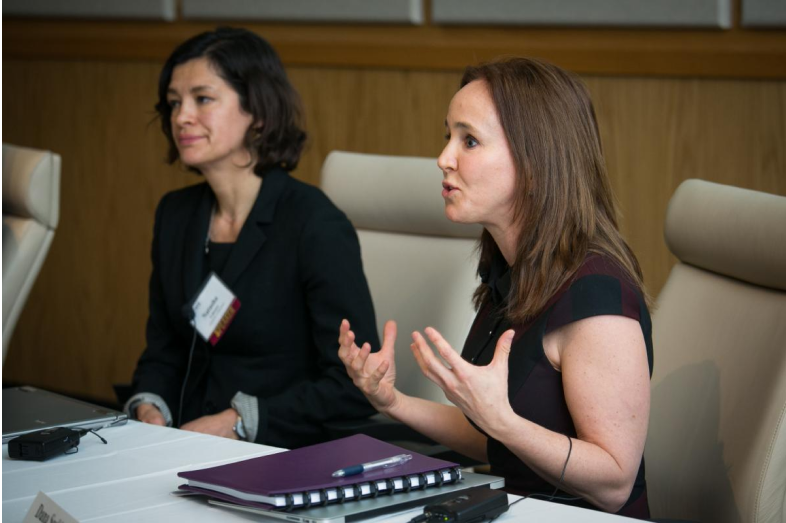

EWA recently hosted a seminar in New Orleans on early childhood education. We asked some of the journalists who attended to contribute posts from the sessions. Today’s guest blogger is Ann Dornfeld of Puget Sound Public Radio. You can also find out more about early childhood education on EWA’s Topics page.
When Professor of Surgery Dr. Dana Suskind started the Pediatric Cochlear Implant Program at the University of Chicago seven years ago, she soon realized that although the surgery brought sound to children’s brains, something else brought language into their lives: their “language environment.”
Suskind found that what her young patients heard after implantation – their language environment – was divided along socioeconomic lines. After she read a 2003 study that found that children born into affluent families hear an average of 30 million more words by age 3 than children born into poverty, Suskind created the Thirty Million Words Initiative to encourage families to speak more to young children.
Suskind told education reporters gathered for EWA’s seminar that while the quantity of words families speak to children is important, so is the quality of their speech. Hart and Risley found that in low-income families, young children are likely to hear short sentences, more directive speech, and fewer encouragements: “Stop,” “Get down,” or “Don’t do that” were common phrases in many homes.
The Thirty Million Words Initiative stresses the value of viewing young children as conversation partners, and using positive language and praise to build children’s vocabularies.
Suskind says parents often think that their children’s intelligence will hinge on their genes, the parents’ educational levels, or other factors beyond their immediate control. A key ingredient in shifting families’ philosophies is explaining to them the degree to which their interactions with their kids affect their children’s intelligence.
Natasha Cabrera, an associate professor of education at the University of Maryland, says current knowledge of what minority children bring to preschool is mostly based on a “deficit” framework – that is, focusing on the half-full glass of academic, social and emotional preparedness. Cabrera says that framework is misleading, at best.
The tremendous variability among minority families has long been ignored, Cabrera told the EWA audience.
Although many children of color come from low-income families, Cabrera says the majority of minority families are not poor. Among those who are, she points out that poverty is on a continuum, and many families are doing better than others within the same low-income bracket.
Regardless of socioeconomic background, Cabrera says minority children and their families bring a lot to the table.
Many live in tightly knit, supportive communities that offer bilingual childcare centers, afterschool programs, and have teachers who care deeply about their students.
The oral history traditions in many minority communities mean that many children of color grow up hearing family stories that inform their world views, Cabrera says.
The bicultural norms many minority children must learn and adopt help them get along with people who are different from them, a key skill at school.
And Cabrera says studies are showing that bilingualism helps develop children’s executive function, by forcing them to control the impulse to speak in a different language. This, she says, carries over to other areas of behavior in bilingual children’s lives.
In fact, Cabrera says, in a lot of studies, minority children tend to be overly self-regulated. In the famous “marshmallow study,” for example, children of color might wait not only for a second marshmallow – but also their mother’s permission to eat the marshmallows.
Although some studies show that the positive test score effects credited to high-quality preschool attendance fade over a student’s school career, economist Tim Bartik told the EWA audience that those early learning experiences can still have large, long-term effects on earnings later in life.
The well-known High/Scope Perry Preschool Project of the 1960s, for example, suggested that preschool attendance among African-American students might predict 3 percent higher adult earnings. Instead, a longitudinal study of the students found that those who attended Perry Preschool enjoyed earnings 19 percent higher than the control group.
Although it’s hard to gauge the exact reasons for the earnings boos, Bartik says he thinks the best theory is that high-quality preschools equip children with the “soft skills” – that is, social or character skills – that improve children’s ability to get along with peers and teachers, and boost their persistence, or grit.
Bartik, of the Upjohn Institute for Employment Research in Kalamazoo, Mich., says if you talk to an employer about what determines success on the job, those soft skills are a major factor: they mean reliability, collegiality, follow-through, and good customer service.
The evidence suggests that the increased earnings preschool graduates enjoy has a huge spillover effect on the entire economy – and that even small increases in skills gleaned from preschool can have large benefits for lifetime adult learnings, Bartik says.
A full-day high-quality early learning program could boost adult earning by 10%, he estimates, while a much more expensive program with very small class sizes, like Educare, could increase later earning by 26%, according to studies.
These large economic effects are not inevitable, Bartik adds, unless the programs are high-quality.